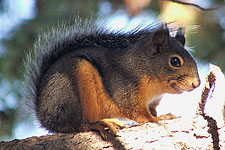Local Wildlife
Douglas' Squirrel

Scientific Name: Tamiasciurus douglasii
Addt'l Info: Univ. of Michigan
The Douglas' squirrel is a small squirrel (10" to 14") with a grayish-brown coat and an orange-hued, cream-colored underside. The ears are slightly tufted and a dark stripe runs down each side (though these are often so faded as to be unnoticable). Its primary diet consists of seeds, fruits, pine nuts, mushrooms, fungi, and assorted vegetation. Predominantly vegetarian, they may eat small insects, birds eggs, and even nestlings when other foods are scarce.
Primarily found in coniferous forests (though they may also inhabit mixed coniferous-hardwood forests), these squirrels live in nests that are built underground or in trees. They use twigs, shredded bark, moss, and lichens to form and line these nests. Douglas' squirrels may be seen from dawn to dusk in any of the forested areas of Sunriver. Look for them sitting on tree limbs while eating or foraging for seeds and nuts on the forest floor.
Like many other squirrels, the Douglas' squirrel is diurnal (meaning primarily active in the morning and evening) and does not hibernate during the winter months, even though during harsh weather they may remain in their nests for extended periods of time. Various calls are used when disputing territory, courting, and warning of danger. In addition, scents are also used to communicate and identify other squirrels.
Douglas' squirrels are not particularly sociable and generally ignore each other except in early spring during courtship. After mating, the male leaves and about five weeks later the female will have a litter of between four and six babies which she will raise alone. Females generally produce one litter (occassionally two) per year with the majority of births occuring during March and May. By the end of the year, the young will be mature and the family will part ways.
